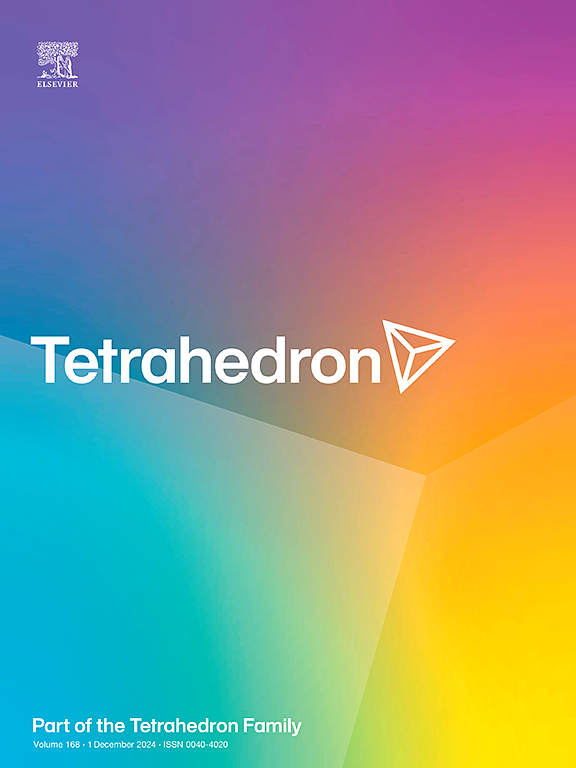Synthesis and characterization of electroluminescent materials: Dinuclear platinum complexes featuring 2-naphthylisoquinoline cyclometalating ligands
IF 2.2
3区 化学
Q2 CHEMISTRY, ORGANIC
引用次数: 0
Abstract
(2niq)2Pt2(μ-PhOXT)2, (2niq)2Pt2(μ-tBuOXT)2 (2niq)2Pt2(μ-C6OXT)2 and (2niq)2Pt2(μ-C12OXT)2, were designed and synthesized, featuring 2-naphthylisoquinoline as the chelating ligand and arylthioxadiazole as the auxiliary ligand. The results showed that the photoluminescence quantum yield (PLQY) of these four dinuclear platinum complexes in dichloromethane solution were 8.2 %, 13.7 %, 18.3 % and 12.6 %, respectively. In pure thin films, their luminescence lifetimes were 1435, 554, 448, and 1266 ns, respectively. Meanwhile, the (2niq)2Pt2(μ-PhOXT)2-, (2niq)2Pt2(μ-tBuOXT)2-, (2niq)2Pt2(μ-C6OXT)2- and (2niq)2Pt2(μ-C12OXT)2-doped polymer light-emitting devices (PLEDs) exhibited deep-red to near-infrared electroluminescence characteristics with emission peaks in the range of 686–706 nm. The maximum external quantum efficiencies (EQEs) were 3.00 %, 3.89 %, 5.03 %, and 5.16 %, respectively. The results revealed that device performance improved with increasing alkyl chain length of the auxiliary ligand, which might be attributed to enhanced charge transport properties. This work provided new insights into the design of efficient deep-red to near-infrared luminescent platinum complexes by introducing alkyl chains into the auxiliary ligands. It offered a novel strategy for modulating the EQEs of the devices based on these platinum complexes from the perspective of auxiliary ligands, thereby advancing PLED applications.

电致发光材料的合成与表征:2-萘基异喹啉环金属化配体双核铂配合物
以2-萘基异喹啉为螯合配体,芳基硫代二唑为辅助配体,设计合成了(2niq)2Pt2(μ-PhOXT)2、(2niq)2Pt2(μ-tBuOXT)2、(2niq)2Pt2(μ-C6OXT)2和(2niq)2Pt2(μ-C12OXT)2。结果表明,这四种双核铂配合物在二氯甲烷溶液中的光致发光量子产率(PLQY)分别为8.2%、13.7%、18.3%和12.6%。在纯薄膜中,它们的发光寿命分别为1435、5554、448和1266 ns。同时,(2niq)2Pt2(μ-PhOXT)2-、(2niq)2Pt2(μ-tBuOXT)2-、(2niq)2Pt2(μ-C6OXT)2-和(2niq)2Pt2(μ-C12OXT)2掺杂的聚合物发光器件(led)表现出深红色到近红外的电致发光特性,发射峰在686 ~ 706 nm范围内。最大外量子效率(EQEs)分别为3.00 %、3.89%、5.03%和5.16%。结果表明,随着辅助配体烷基链长度的增加,器件性能得到改善,这可能是由于电荷输运性质的增强。本工作通过在辅助配体中引入烷基链,为设计高效的深红色至近红外发光铂配合物提供了新的见解。从辅助配体的角度出发,为基于铂配合物的器件的EQEs调制提供了一种新的策略,从而促进了PLED的应用。
本文章由计算机程序翻译,如有差异,请以英文原文为准。
求助全文
约1分钟内获得全文
求助全文
来源期刊

Tetrahedron
化学-有机化学
CiteScore
3.90
自引率
4.80%
发文量
439
审稿时长
34 days
期刊介绍:
Tetrahedron publishes full accounts of research having outstanding significance in the broad field of organic chemistry and its related disciplines, such as organic materials and bio-organic chemistry.
Regular papers in Tetrahedron are expected to represent detailed accounts of an original study having substantially greater scope and details than that found in a communication, as published in Tetrahedron Letters.
Tetrahedron also publishes thematic collections of papers as special issues and ''Reports'', commissioned in-depth reviews providing a comprehensive overview of a research area.
 求助内容:
求助内容: 应助结果提醒方式:
应助结果提醒方式:


